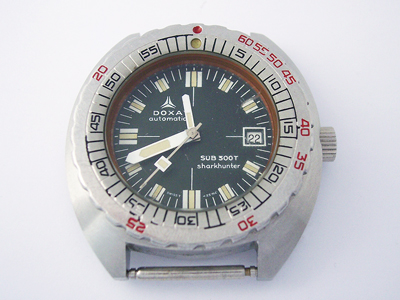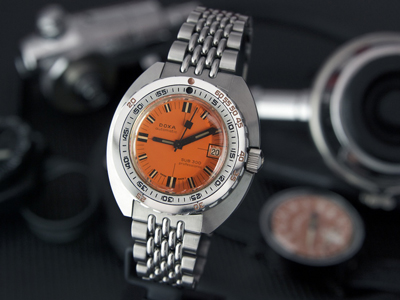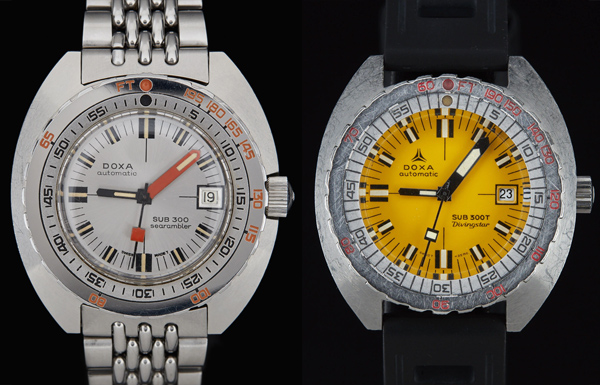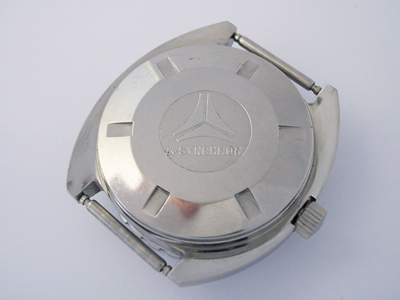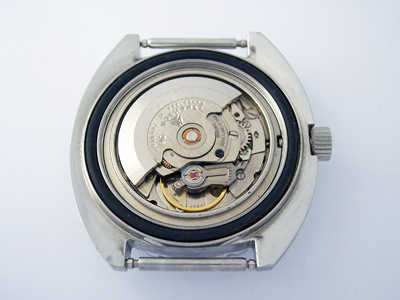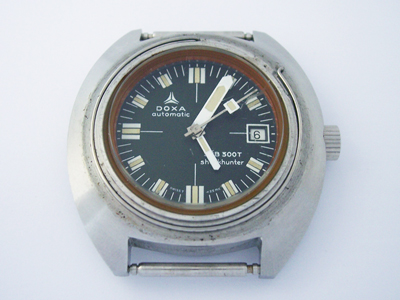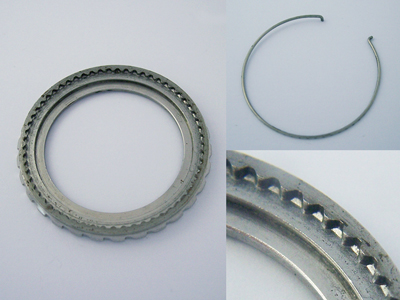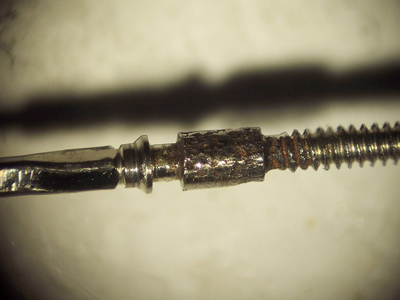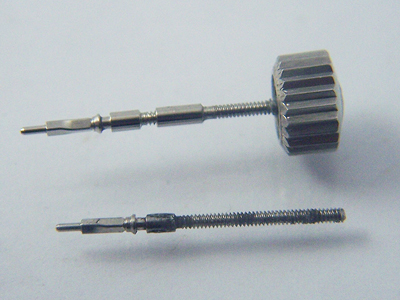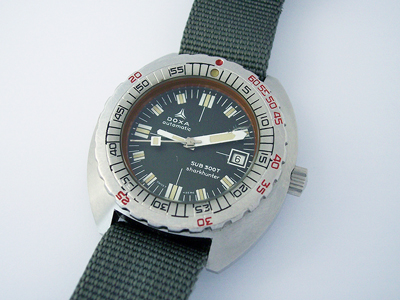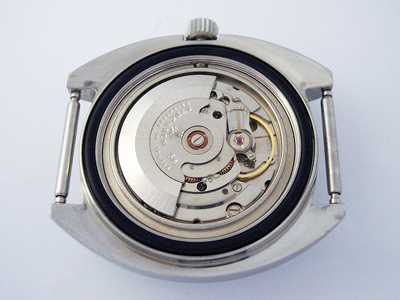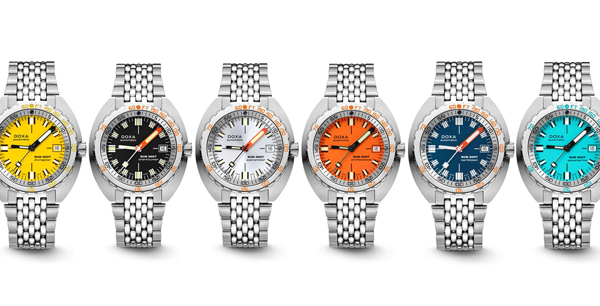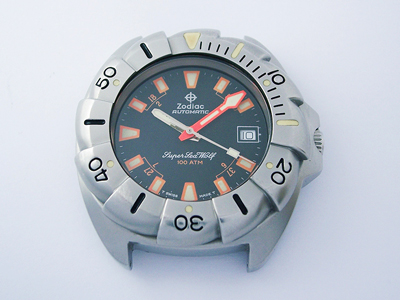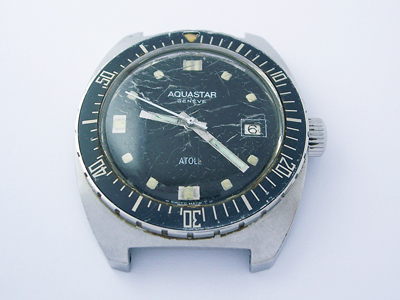Keeping the theme of chunky divers going, this time it’s a classic and another new brand for the blog, the Doxa SUB 300T Sharkhunter.
(Click pictures to enlarge)
Although Doxa S.A. was founded by Georges Ducommun in the Jura Valley way back in 1889, their most recognisable watch is undoubtedly the SUB 300T. Developed in the late 1960’s, Doxa consulted with a number of divers, including the legendary Jacques Cousteau, to develop a watch specifically for scuba diving.
The resulting watch was undeniably fit for purpose and included a number of distinctive features; a bright orange dial and contrasting black hands as this was thought to be more visible at depth, two scales on the bezel (the traditional dive timer on the inner scale and a decompression scale on the outer) and also a flexible beads-of-rice bracelet with a spring loaded extension on the clasp allowing the the watch to be worn over a wet-suit.
Though the SUB 300T proved to be a commercial success for the brand, at the time of its development Doxa were facing hard times and joined the ASAUG (Allgemeine Schweizerische Uhrenindustrie AG) in 1968 to ensure their survival. Placed in the newly formed Synchron group alongside Ernest Borel and Cyma, the three brands were marketed together throughout the 1970’s, which is why you’ll see the Synchron brand and logo on many of their watches, including the subject of this post.
Though the original watch had a bright orange dial, other variants soon followed, each with its own model name; the Sharkhunter (black dial) as seen in this post, the Searambler (silver dial) and the Divingstar (yellow dial).
The Sharkhunter in this post arrived in running condition and just needed a movement service and a general tidy up. There was an issue with the crown and stem however as it would frequently skip positions when setting the date or time.
Turning the watch over, the Synchron branding features on the caseback…
… and inside is an ETA cal. 2783, a reliable Swiss ‘work horse’ calibre found in many watches from this period. Running at 21,600 bph, with a handy quickset for the date via the crown, it was available in 17, 21 and 25 jewel variants, the one here is 17 jewel. You can see too that the rotor is again signed with the Synchron, rather than Doxa, name and logo.
Before moving on it’s worth taking a minute to look at the bezel construction. As the bezel has two separate scales, you may imagine that they can be moved independently, but that isn’t the case. Both scales are engraved onto a single piece of metal and rotate together – but only in an anti-clockwise direction.
A uni-directional bezel is a common feature of many dive watches and serves as a built-in safety feature for the diver. Should the bezel be moved accidentally during a dive, it will always reduce the amount of dive time left rather than increase it, removing the risk of running out of oxygen accidentally while submerged.
With the bezel removed, you can see how this is achieved. Under the bezel is a substantial wire spring (to be fair, everything about this watch is ‘substantial’), shaped so that one end slots vertically into a hole in the case above the 12 hour marker and the other end is bent outwards horizontally.
On the underside of the bezel are a number of serrations in which the outer end of the bezel spring rests (60 serrations in total for this watch, the bezels on some dive watches have 120 for increased accuracy).
When the bezel is rotated anti-clockwise, the spring flexes towards the centre of the case and the end of the spring passes along to the next serration. When the bezel is rotated clockwise, the spring is bent away from the case and the spring end jams into the serration, stopping the rotation. It’s a simple but clever solution.
The movement was generally in good condition, though as I mentioned earlier, there was an issue with the stem skipping positions in use. On closer inspection it occurred that the stem body had quite a lot of pitting and was no longer engaging securely with the set lever.
A new stem was the only solution but being long discontinued, choices were limited. The only stems available were not long enough to fit the (substantial.. haha!) 43mm Doxa case, so a stem extender was needed to complete the repair.
With that problem solved, the rest of the job was straight forward, the movement was serviced, the case cleaned and the watch rebuilt. Sure, the watch still has some signs of use; sections of paint missing from the bezel markings, scratches on the crystal etc, but signs of previous adventures suit a watch of this type perfectly.
While finding a vintage SUB 300T is certainly not impossible these days, it may be useful to know that Doxa have re-issued several versions of the SUB 300T over the last few years, including 50th anniversary models and the Conquistador collection in late 2019.
Maintaining the same dimensions and released in six colours (yes six!) the watches are powered by the ubiquitous ETA cal. 2824-2 and have a depth rating of a whopping 1200 metres.
Pssssst…. track down a vintage one (complete with a few scars), they’re so much cooler. 🙂
Rich.
** Many thanks to Chris Sully for letting me feature his watch on the blog. **

